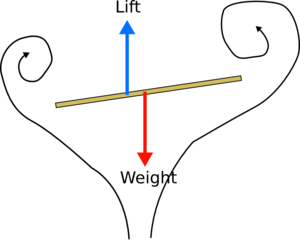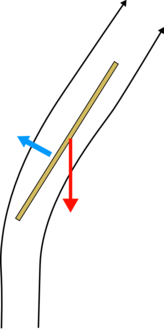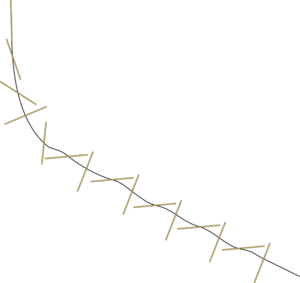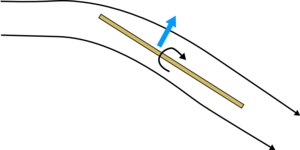Ingredients
2 playing cards, and somewhere more than 2.5m high to drop them from.
Instructions
Hold the cards about 0.5m up.
Hold one card vertically and one horizontally in the middle of each card and then let go of both together. Make sure you release them cleanly.
Which hits the ground first?
Stand over a drop, (standing on a stable table will probably work but be careful).
Result
You should find that the flat card falls staying horizontal all the way down, but the vertical card starts to spin, and as it does so it starts to glide horizontally.
The vertical card falls quicker to start with as it is edge on to the air and has much less air resistance, but if it falls far enough the horizontal card will catch up and overtake it.
Explanation
The flat card falls fairly stabily just sliding from side to side, where as the vertical card starts to fall more quickly then starts to spin, and as it does so it glides sideways. This gliding is actually slower than the the flat card falling.
The flat card is stable because if it starts to tip slightly, air is deflected sideways which makes the lift asymmetrical, the point of maximum lift is on the lowest side so it gets moved back up. In the process the slides sideways dropping much faster than it would do normally. The vertical card on the other hand is unstable as the asymmetric lift tends to increase any slight angle it starts at. This means that it starts to spin, and by the time it is horizontal it has enough momentum to carry on going. The spinning card deflects air downwards so the air pushes the card up producing lift, so the spinning card starts off falling quickly and then starts to spin and glides. Why doesn't it stop spinning? This spin is maintained and increased partly because the air is deflected more when the front of the card is moving in the same direction as the air than when it is spinning against it. This means there is more lift upwards when the front of the card is pointing up, than downwards when the card is pointing down, so this produces an overall lift, and because the lift is asymmetric it acts to speed up the spin. The difference between the two cases is made even larger as it takes some time for the air to attach and detach from the card, which means it gets upward lift for longer and it starts producing downward lift later in each rotation. 

The flat card at a slight angle produces lift which pushes it flat again The vertical card on the other hand is pushed to be less vertical and starts to spin. 


If the front of the card is spinning with the air it deflects it a lot producing a lot of lift, this both lifts the card and pushes it around. If it is moving in the opposite direction the air detaches more easily at a smaller andgle and so produces less lift in the wrong direction, so overall the card feels an upward force.
- Previous Bouncing Soap
- Next The Thatcher Illusion










Comments
Add a comment